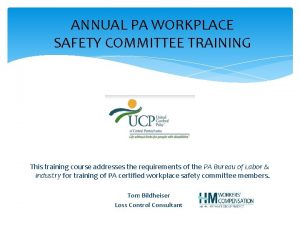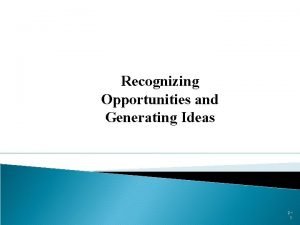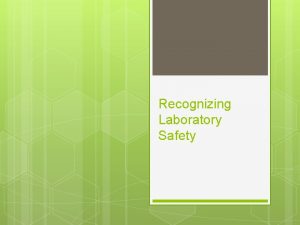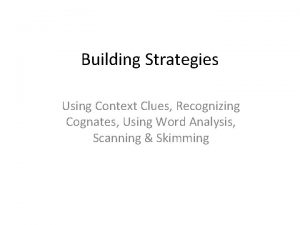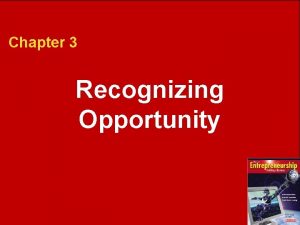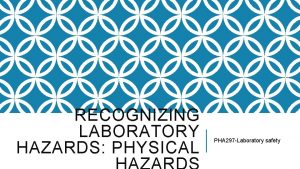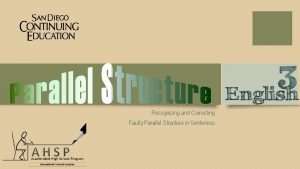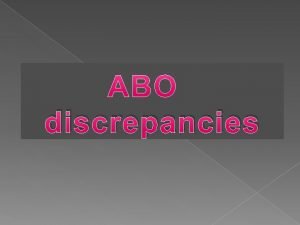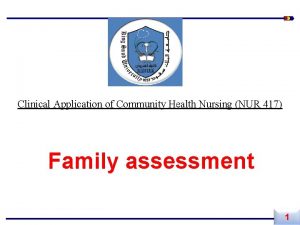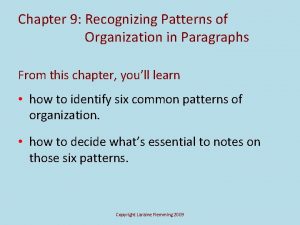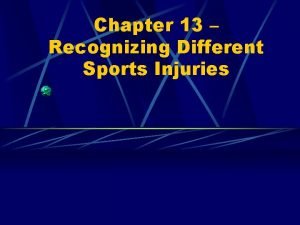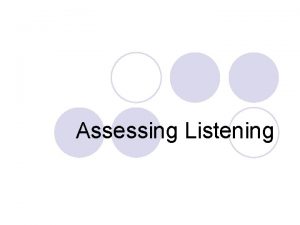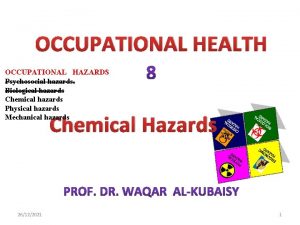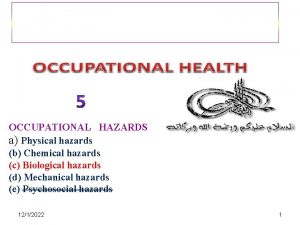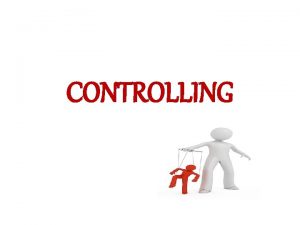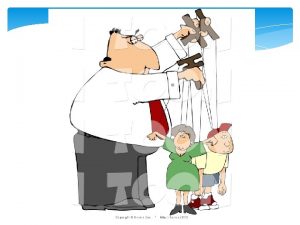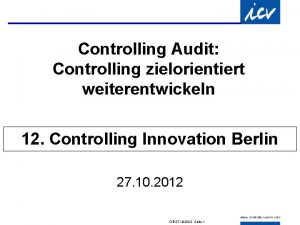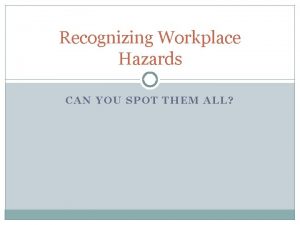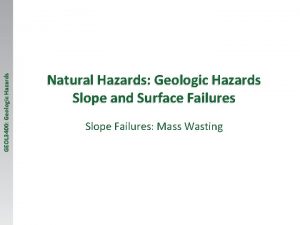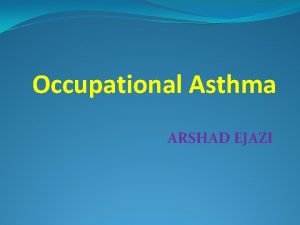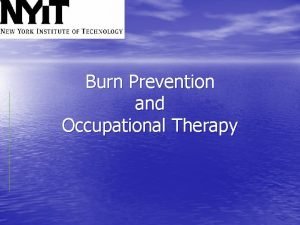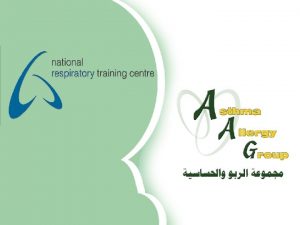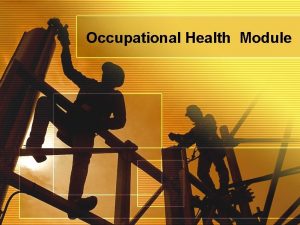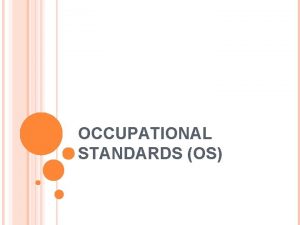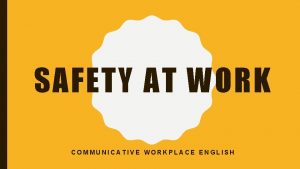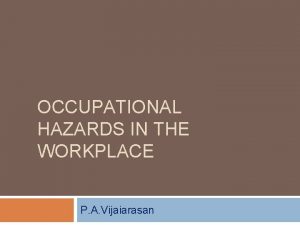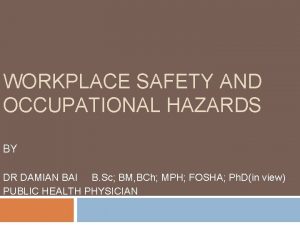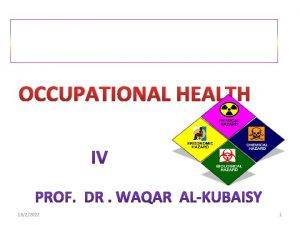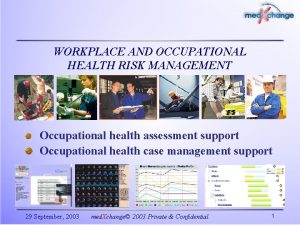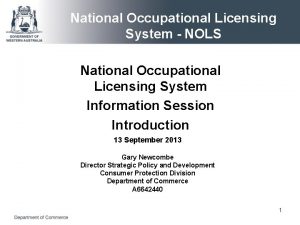Recognizing Controlling Workplace Hazards National Council for Occupational








![Health hazards- Biological <<<<<<<<<<<<< HIV Flu Hepatitis Tuberculosis Insect/animal {Lyme disease, rabies] Health hazards- Biological <<<<<<<<<<<<< HIV Flu Hepatitis Tuberculosis Insect/animal {Lyme disease, rabies]](https://slidetodoc.com/presentation_image_h/2513ffe686daa3f1c242f488ab708ffa/image-9.jpg)

![Physical hazards <<<<<<<<< Impacts: Deafness Burns, blood disorders, cancer Musculoskeletal injury Heat stroke [hypothermia] Physical hazards <<<<<<<<< Impacts: Deafness Burns, blood disorders, cancer Musculoskeletal injury Heat stroke [hypothermia]](https://slidetodoc.com/presentation_image_h/2513ffe686daa3f1c242f488ab708ffa/image-11.jpg)
















- Slides: 27

Recognizing & Controlling Workplace Hazards National Council for Occupational Safety and Health

What is a job hazard?

Job Hazards A job hazard is anything at work that can hurt you either physically or mentally. Safety hazards cause immediate injury: direct injury or trauma such as a severed finger, puncture wound, a crushed hand, broken bones, eye damage. n Health hazards can cause illness immediately (acute) or over a longer time (chronic), n

Safety hazards n n n Unguarded machinery/equipment Electrical hazards: damaged plugs, outlets, wires. Unbalanced walking surface (Pushing, pulling, lifting) bulky/heavy objects Tripping hazards

Safety hazards Heights n Falling objects n Slippery floors n Holes in ceiling or floor n Blind spots (vehicles) n Power tools n

Health hazards

Health hazards Chemicals n Dusts, vapors gases, Acids, solvents, cleaning products, pesticides Effects: Flammable (fire& explosion) Burn (eyes skin lungs) Effect target organs (liver, blood, brain and nervous system, lungs, skin. )

Health hazards <<<<<<<<<<<<<< n Biological hazards: living organisms Animals/ Insects/ blood / Bacteria Viruses
![Health hazards Biological HIV Flu Hepatitis Tuberculosis Insectanimal Lyme disease rabies Health hazards- Biological <<<<<<<<<<<<< HIV Flu Hepatitis Tuberculosis Insect/animal {Lyme disease, rabies]](https://slidetodoc.com/presentation_image_h/2513ffe686daa3f1c242f488ab708ffa/image-9.jpg)
Health hazards- Biological <<<<<<<<<<<<< HIV Flu Hepatitis Tuberculosis Insect/animal {Lyme disease, rabies]

Physical hazards <<<<<<<<<< Noise Radiation Repetitive motion Heat, Cold stress
![Physical hazards Impacts Deafness Burns blood disorders cancer Musculoskeletal injury Heat stroke hypothermia Physical hazards <<<<<<<<< Impacts: Deafness Burns, blood disorders, cancer Musculoskeletal injury Heat stroke [hypothermia]](https://slidetodoc.com/presentation_image_h/2513ffe686daa3f1c242f488ab708ffa/image-11.jpg)
Physical hazards <<<<<<<<< Impacts: Deafness Burns, blood disorders, cancer Musculoskeletal injury Heat stroke [hypothermia]

Controlling Hazards Remove the Hazard (e. g. , change the process, use safer chemicals, ) Work Policies and Procedures (e. g. , planning, work in teams, mentor) Personal Protective Equipment (e. g. , hardhat, goggles, gloves, respirator)

Why does it matter?

Why does it matter? 18 year old – Sylvia Cabbage Shredder Operations So Far of Hand – Caught Hand in Electric Permanently Disfigured, 4 Will Never Have Full Use 16 year old – Donna –Working alone in Sandwich Shop after 11 pm. Seriously injured when assaulted during an armed robbery 17 Year Old – Michael –died of suffocation working at Market for 3 months supervisor told him to go operate the cardboard compactor/baler- While extracting a stuck piece of cardboard, was pulled inside the machine. Hydraulic compressor slowly crushed his chest.

Why does it matter? n n 84, 000 <18 -year-olds to the ER for work injuries n 70 <18 -year-olds die each year n 90 18 -19 year-olds die each year Young workers are injured at a higher rate than adult workers. n 250, 000 <18 -year-olds injured/year in the US

Finding Hazards: Key Points n n n Every job has health and safety hazards, and they can be controlled. You should always be made aware of these hazards. And follow safety rules that protect you and coworkers. It is the legal responsibility of the employer to identify workplace hazards and to train you about them and how you are protected from them.


Illustrated Workplaces Find the Hazards: Food Service

Food Service n n n n Sharps Slips and falls Chemicals Burns: stove grill (grease) Lifting Violence Heat

Find the Hazards: Office

Office n n n Posture (work station) Tripping hazards Sharps Hit by Electrical? evacuation

OSHA n n n OSHA has the authority to make rules and standards on health and safety in the workplace. OSHA inspects work sites to determine if there are hazards and violations of its rules and standards. OSHA responds to complaints about safety and health. OSHA issues citations and fines against employers who fail to meet standards or who violate the law. OSHA offers training and technical assistance to employers who ask about hazards and methods of controlling hazards.

Example of an OSHA rule Employers must have a chemical safety plan called a Hazard Communication Program. This requires labels on chemical containers with information about a product’s hazards. n n Workers should be instructed about chemicals hazards, and how to handle and use and store these safely

Job Safety and Health: Key Points n n n OSHA requires employers to provide a safe workplace. It’s best to get rid of a hazard completely, if possible. If your employer can’t get rid of the hazard, there are usually many ways to protect you from it.

Training: developing a Job Hazard Map

Draw a map (floor plan) of a work site n Draw layout of work space, any machinery, equipment, workers, etc n List safety hazards n List any health hazards

The National Council for Occupational Safety and Health coshnatl@gmail. com n This material was adapted from materials produced by the Rhode Island Committee on Occupational Safety and Health and the US Occupational Safety and Health Administration USDOL/OSHA. This material was produced under grant number SH 20853 SH 0 from the Occupational Safety and Health Administration, U. S. Department of Labor. It does not necessarily reflect the views or policies of the U. S. Department of Labor, nor does mention of trade names, commercial products, or organizations imply endorsement by the U. S. Government.
 Workplace transport hazards
Workplace transport hazards Physical hazards
Physical hazards Identification of hazards in the workplace
Identification of hazards in the workplace National occupational classification
National occupational classification What is useful materials and harmful materials
What is useful materials and harmful materials Listening for specific details top down or bottom up
Listening for specific details top down or bottom up Chapter 3 recognizing opportunity
Chapter 3 recognizing opportunity Trends and opportunities examples
Trends and opportunities examples Argumentative text anchor chart
Argumentative text anchor chart Channel design decisions example
Channel design decisions example Recognizing opportunities and generating ideas
Recognizing opportunities and generating ideas Recognizing lab safety worksheet answer key
Recognizing lab safety worksheet answer key Entrepreneurial trends
Entrepreneurial trends An opportunity has four essential qualities it is
An opportunity has four essential qualities it is Strategy: recognizing cognates
Strategy: recognizing cognates Recognizing genre - argumentative text
Recognizing genre - argumentative text Chapter 3 recognizing opportunity
Chapter 3 recognizing opportunity Recognizing laboratory safety
Recognizing laboratory safety I have always enjoyed reading the book more than
I have always enjoyed reading the book more than Recognizing antecedents
Recognizing antecedents Recognizing and resolving abo discrepancies
Recognizing and resolving abo discrepancies Recognizing interruptions of health development
Recognizing interruptions of health development Simple listing paragraph
Simple listing paragraph Chapter 13 worksheet recognizing different sports injuries
Chapter 13 worksheet recognizing different sports injuries Paraphrase recognition listening
Paraphrase recognition listening Sensory language definition
Sensory language definition Marketing channel design
Marketing channel design Chapter 3 recognizing opportunity
Chapter 3 recognizing opportunity


